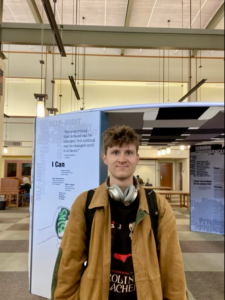By Joshua Perry 
“The Bias Inside Us,” a traveling exhibit from the Smithsonian running here at the Evanston Public Library until May 8, is all about the prejudices in our society. Its mission is to educate people about the social science behind bias and raise awareness of the negative impact it has on our culture and acceptance of others.
I took a Monday afternoon to take a walk through the exhibit and see what it has to offer, and I was amazed by the depth of information I found there. These past two years have seen a huge transformation in the way Americans — including myself — view bias, racism, and discrimination in our society. I thought by now I’d already learned a lot about how those systems oppress marginalized communities in our country, but “The Bias Inside Us” showed me how much more there is to know.
Bias, the exhibit explains, is a psychological trait that everybody possesses in one form or another — it’s totally natural. The brain is hard-wired to constantly process notions of comfort and familiarity, along with unfamiliarity and distrust. These notions can be explicit (biases we’re aware of) or implicit (biases we reinforce unconsciously), and they affect us all. One panel at the exhibit displays a quote from Stanford social psychologist Jennifer L. Eberhardt: “When people think about racism they’re thinking about bigots. But you don’t have to have a moral failing to act on an implicit bias.”
The problem comes up when we don’t acknowledge and check our biases, when we forget they’re there, letting them rule our daily lives. There’s no way for anyone to objectively perceive the world, because everyone has a different pair of shoes they’ve been walking in their entire lives.
“The Bias Inside Us” helps you take those shoes off, step into someone else’s, and take a trip around the block, so to speak.
The exhibit stresses that we’ve all had different experiences. There are several striking, informative video testimonials that help illustrate how these experiences affect the lives of those around us and how they can lead to discrimination. In particular, “The Bias Inside Us” highlights the way communities of color can face prejudice and biased treatment — not only from egregious acts of racism, but also from day-to-day microaggressions and harder-to-detect systematic mistreatment.
Spanish photographer Angélica Dass’ Humanæ photography project, Humanæ rounds out the exhibit, challenging our preconceived judgements of people with different skin colors by showing just how diverse and nuanced every person’s physical appearance truly is and demonstrating the socially constructed nature of racial boundaries.
At the end of the day, none of us look quite the same, but fundamentally we’re all human. Our differences deserve to be embraced.
The exhibit’s big message is that bias doesn’t have to rule our society.
“Just as we can fortify our biases, we can also disrupt them,” the exhibit reads. It’s a great way to think about these problems: bias is reinforced with every tiny decision we make to follow its guidance and live unexamined lives. But by the same token, every tiny decision we make to overcome our biases weakens them more and more.
The Library is such a fitting place to house an exhibit like this. It’s not just a building with books: a library is a place where we can reflect on different perspectives, challenge ourselves with new ideas, and open our minds to the stories others have to share. Visiting “The Bias Inside Us” is a perfect opportunity to do just that.
